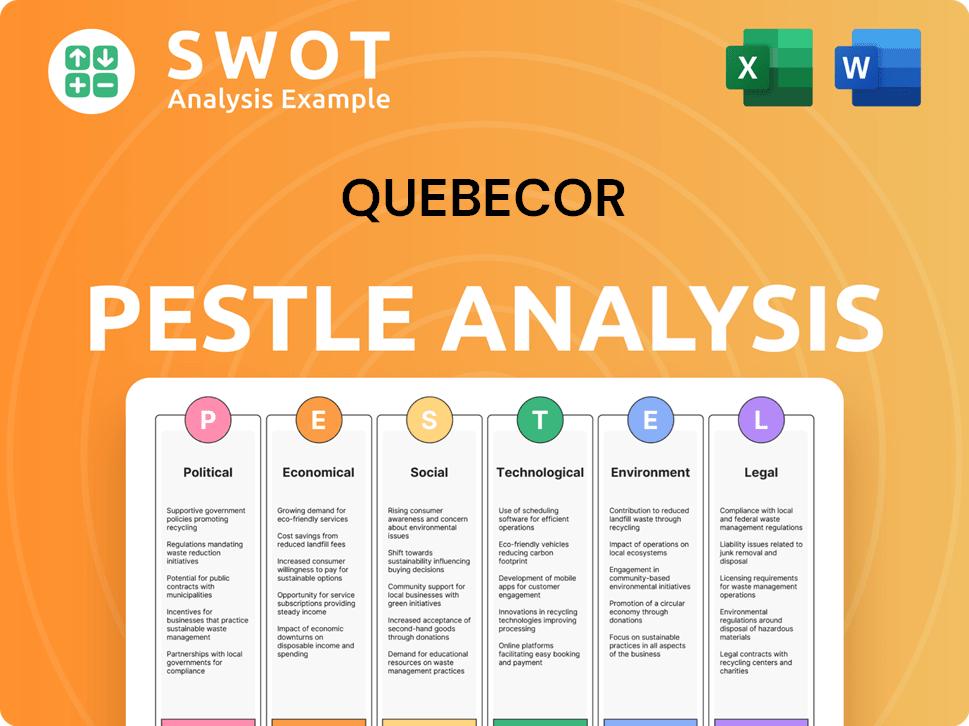Quebecor Bundle
Who Really Controls Quebecor?
Unraveling the ownership of a major corporation like Quebecor is key to understanding its strategic moves and market position. From its humble beginnings as a printing company, Quebecor Inc. has transformed into a media and telecommunications powerhouse. This evolution, guided by its ownership structure, has shaped its trajectory in the competitive Canadian market.

Founded by Pierre Péladeau, Quebecor's journey from a printing business to a media giant is a compelling story of vision and adaptation. The company's headquarters is located in Montreal, Quebec, and its substantial market presence, particularly in Quebec, underscores the significance of understanding its ownership. This analysis will delve into Quebecor SWOT Analysis, exploring the intricate details of who owns Quebecor and the impact of this ownership on its future, including its relationship with Videotron and other subsidiaries.
Who Founded Quebecor?
The story of Quebecor begins in 1965, when Pierre Péladeau established the company as a printing business. Péladeau, a lawyer and businessman, had a clear vision: to build a strong presence in the media industry. This marked the start of what would become a significant player in Canadian media.
From its inception, Quebecor ownership was largely centered around Péladeau. While specific ownership details from the early private phase aren't fully public, Péladeau's control was key to the company's early growth. Early financial support likely came from Péladeau's personal resources and potentially from local financial institutions or private investors.
During the initial phase, Pierre Péladeau maintained a controlling interest, which allowed him to guide the company's strategic direction. This centralized control was crucial for swift decision-making and the aggressive expansion that characterized Quebecor Inc.'s early years. The founder's vision included diversifying into various media segments, from newspapers to broadcasting, which was directly linked to his control over the company's assets and growth strategy.
Quebecor's early ownership structure was primarily shaped by its founder, Pierre Péladeau. His leadership was instrumental in the company's initial growth and its strategic direction. The company's evolution from a printing business to a diversified media conglomerate reflects Péladeau's vision and control.
- Pierre Péladeau's control was essential for early strategic decisions.
- Early backing likely came from personal capital and local investors.
- The founder's vision drove diversification into media segments.
- There is no widely documented information regarding early ownership disputes or buyouts during this formative period.
Quebecor SWOT Analysis
- Complete SWOT Breakdown
- Fully Customizable
- Editable in Excel & Word
- Professional Formatting
- Investor-Ready Format

How Has Quebecor’s Ownership Changed Over Time?
The evolution of Quebecor's ownership has been marked by strategic decisions since its initial public offering (IPO). While the exact IPO date isn't immediately available, Quebecor Inc. has been listed on the Toronto Stock Exchange (TSX) under the symbols QBR.A and QBR.B for a considerable period. The Péladeau family has maintained control, typically through a dual-class share structure, allowing them to retain significant influence while accessing public capital. This structure is a common practice among Canadian companies.
The Péladeau family, particularly Pierre Karl Péladeau, has remained the dominant shareholder as of early 2025. This control is primarily exerted through Class A subordinate voting shares, which offer greater voting rights compared to the Class B shares available to the public. Major institutional investors, mutual funds, and index funds also hold substantial stakes, reflecting Quebecor ownership's presence in various market indices. These institutional investors influence governance through their collective voting power, even if they don't hold a controlling stake.
| Key Event | Impact on Ownership | Year |
|---|---|---|
| Initial Public Offering (IPO) | Allowed access to public capital, but the Péladeau family retained control. | Not readily available |
| Strategic Acquisitions | Consolidated the company's position in media and telecommunications, often guided by the controlling family. | Ongoing |
| Dual-Class Share Structure | Enabled the Péladeau family to maintain control with a smaller percentage of the overall shares. | Ongoing |
The strategic direction of Quebecor, including its expansion into telecommunications with Vidéotron and its content creation initiatives, has been shaped by the Péladeau family's vision. Changes in Quebecor's ownership, such as acquisitions and partnerships, have often been orchestrated under the guidance of the controlling family. To understand more about the company's trajectory, you can explore the Growth Strategy of Quebecor.
The Péladeau family, led by Pierre Karl Péladeau, maintains significant control of Quebecor through a dual-class share structure.
- Institutional investors hold significant stakes, influencing governance.
- Strategic decisions, including acquisitions and partnerships, are often guided by the controlling family.
- The company's focus includes telecommunications (Vidéotron) and content creation.
- Quebecor is publicly traded on the TSX under QBR.A and QBR.B.
Quebecor PESTLE Analysis
- Covers All 6 PESTLE Categories
- No Research Needed – Save Hours of Work
- Built by Experts, Trusted by Consultants
- Instant Download, Ready to Use
- 100% Editable, Fully Customizable

Who Sits on Quebecor’s Board?
The Board of Directors of Quebecor Inc. is central to the company's governance. As of early 2025, the board includes a mix of representatives aligned with the major shareholders, particularly the Péladeau family, and independent directors. Pierre Karl Péladeau, serving as President and CEO, is a key figure on the board, directly representing the controlling family's interests. Other board members bring experience from media, telecommunications, and finance, with some independent directors to ensure oversight and diverse perspectives. Understanding the composition of the board is critical to grasping the dynamics of Quebecor ownership.
The board's composition reflects the company's strategic direction, influenced heavily by the Péladeau family's control. The presence of independent directors provides a balance, offering different viewpoints on key decisions. This structure aims to balance the interests of the controlling shareholders with the broader needs of the company and its stakeholders. The board's decisions are crucial in shaping the future of Quebecor, including its subsidiaries like Videotron.
| Board Member | Role | Affiliation |
|---|---|---|
| Pierre Karl Péladeau | President and CEO | Péladeau Family |
| [Name Redacted] | Director | Independent |
| [Name Redacted] | Director | Péladeau Family Representative |
Quebecor Inc operates with a dual-class share structure, which significantly impacts its voting power. This structure involves Class A shares, mainly held by the Péladeau family, with superior voting rights, and Class B subordinate voting shares, which are publicly traded. This arrangement ensures that the Péladeau family retains effective control over strategic decisions, including director elections and major corporate actions. This structure allows the company to pursue long-term strategies without being unduly influenced by short-term market pressures. For more context, consider reading a Brief History of Quebecor.
The Board of Directors at Quebecor is a blend of family representatives and independent directors.
- Pierre Karl Péladeau leads the board as President and CEO.
- The dual-class share structure gives the Péladeau family significant voting power.
- This structure allows for long-term strategic planning.
- Understanding the board's composition is key to understanding Quebecor ownership.
Quebecor Business Model Canvas
- Complete 9-Block Business Model Canvas
- Effortlessly Communicate Your Business Strategy
- Investor-Ready BMC Format
- 100% Editable and Customizable
- Clear and Structured Layout

What Recent Changes Have Shaped Quebecor’s Ownership Landscape?
Over the past few years, the ownership profile of Quebecor has remained relatively stable, with the Péladeau family maintaining significant control. This stability is largely due to the company's dual-class share structure, which insulates it from significant dilution pressures. However, strategic initiatives and market dynamics continue to shape its ownership landscape. For instance, share buybacks could increase the percentage ownership of existing shareholders, including the Péladeau family and long-term institutional investors.
A key development affecting Quebecor
is its strategic moves in the telecommunications sector. The acquisition of Freedom Mobile by Videotron, a Quebecor subsidiary, in April 2023 for an enterprise value of approximately $2.85 billion, is a prime example. While this doesn't directly alter Quebecor Inc.'s ownership, it significantly expands the company's asset base and revenue streams. Such large-scale transactions can prompt institutional investors to re-evaluate their stakes based on the perceived value and strategic fit of the combined entity.
| Aspect | Details | Impact |
|---|---|---|
| Péladeau Family Control | Maintains significant control via dual-class shares. | Ensures stability and long-term vision. |
| Institutional Ownership | Influenced by strategic acquisitions and market trends. | Can lead to shifts in shareholder composition. |
| Strategic Acquisitions | Example: Freedom Mobile acquisition by Videotron. | Expands asset base and revenue streams. |
Industry trends, such as increased institutional ownership and consolidation, also affect Quebecor. The rise of activist investors is a factor, though mitigated by the control structure. Public statements from Pierre Karl Péladeau
often reinforce the company's long-term vision. Any future succession plans within the Péladeau family or structural changes will be closely monitored by the market. As of 2024, the company's focus remains on strategic growth, particularly within its core sectors, which indirectly influences investor interest and ownership patterns.
The Péladeau family maintains significant control, ensuring stability. The dual-class share structure helps insulate the company from dilution. This structure allows for a long-term strategic vision.
Videotron's acquisition of Freedom Mobile expanded its wireless footprint. This move influences the company's asset base. Such acquisitions can affect institutional investor interest.
Increased institutional ownership and consolidation are relevant. Activist investors are a factor, though mitigated by the control structure. The market closely watches any structural changes.
The company is focused on strategic growth, particularly in its core sectors. This focus indirectly influences investor interest. Succession plans within the Péladeau family are closely watched.
Quebecor Porter's Five Forces Analysis
- Covers All 5 Competitive Forces in Detail
- Structured for Consultants, Students, and Founders
- 100% Editable in Microsoft Word & Excel
- Instant Digital Download – Use Immediately
- Compatible with Mac & PC – Fully Unlocked

Related Blogs
- What are Mission Vision & Core Values of Quebecor Company?
- What is Competitive Landscape of Quebecor Company?
- What is Growth Strategy and Future Prospects of Quebecor Company?
- How Does Quebecor Company Work?
- What is Sales and Marketing Strategy of Quebecor Company?
- What is Brief History of Quebecor Company?
- What is Customer Demographics and Target Market of Quebecor Company?
Disclaimer
All information, articles, and product details provided on this website are for general informational and educational purposes only. We do not claim any ownership over, nor do we intend to infringe upon, any trademarks, copyrights, logos, brand names, or other intellectual property mentioned or depicted on this site. Such intellectual property remains the property of its respective owners, and any references here are made solely for identification or informational purposes, without implying any affiliation, endorsement, or partnership.
We make no representations or warranties, express or implied, regarding the accuracy, completeness, or suitability of any content or products presented. Nothing on this website should be construed as legal, tax, investment, financial, medical, or other professional advice. In addition, no part of this site—including articles or product references—constitutes a solicitation, recommendation, endorsement, advertisement, or offer to buy or sell any securities, franchises, or other financial instruments, particularly in jurisdictions where such activity would be unlawful.
All content is of a general nature and may not address the specific circumstances of any individual or entity. It is not a substitute for professional advice or services. Any actions you take based on the information provided here are strictly at your own risk. You accept full responsibility for any decisions or outcomes arising from your use of this website and agree to release us from any liability in connection with your use of, or reliance upon, the content or products found herein.